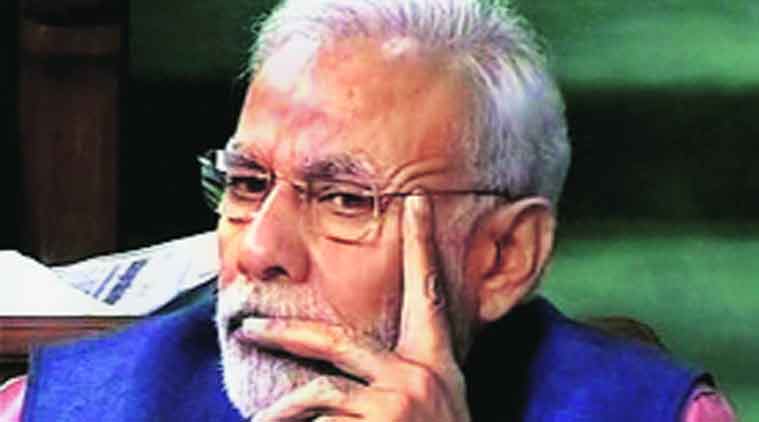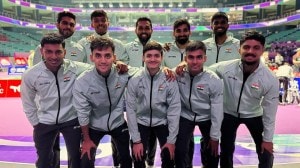- India
- International
We did it first: Congress falls back on Narasimha Rao to punch holes in Modi speech
The Congress alleged that Modi misled the House and indicated that the party could raise a question of privilege in the House.
 Prime Minister Narendra Modi in Parliament
Prime Minister Narendra Modi in Parliament
The Congress always downplayed contributions of its late Prime Minister P V Narasimha Rao. But in a rare move on Wednesday, the party invoked Rao and recounted a couple of initiatives of his government to counter Prime Minister Narendra Modi’s argument in Rajya Sabha on Tuesday that several of UPA’s programmes were recycled versions of A B Vajpayee government’s initiatives.
The Congress alleged that Modi misled the House and indicated that the party could raise a question of privilege in the House. “If legally found admissible, why action will not be taken,” party spokesman Abhishek Singhvi said at the AICC briefing when asked if the party was contemplating moving the Privileges Committee.
Singhvi said many of the schemes listed out by the Prime Minister were “conceptualised” by the UPA government and many “started in the original form” during the 1991-1996 Congress government led by Rao.
What Modi said and what the Congress claimed:
* The PM said the Vajyapee government had a scheme named “Multipurpose National Identity Project”, which the UPA brought in as “Aadhaar UIDAI”.
The Congress said while the BJP manifesto of 1999 promised a national register of citizens and a multipurpose national identity project, it did nothing and repeated the promise in 2009. Singhvi said the NDA government in September 2003, six months before elections, merely said the government is contemplating preparation of a national register of Indian citizens and the issue of multipurpose national identity cards. The Congress, he said, promised in its manifesto in 2004 and the first tranche of multipurpose national identity card was handed over in May 2007.

* Modi said there was Sarva Shiksha Abhiyan during NDA’s tenure while the UPA brought the “Right of Children to Free and Compulsory Education Act”.
The Congress said the Sarva Shiksha Abhiyan was nothing but the district primary education programme “started by us in 1993-94”, the object of both of which was universal primary education.
* The PM said the NDA government brought the Insurance Regulatory and Development Authority and the UPA set up a similar body in the pension sector.
The Congress said the 1999 Insurance Regulatory Act owes is genesis to the Malhotra committee report. The committee was constituted by the Rao government in 1993 and its report came in January 1994, Singhvi said.
* The PM said there was Antyodaya Anna Yojana, under which the poorest of poor households are entitled to food grains every month at subsidised rates — and the UPA brought in the National Food Security Act. Singhvi said the Antyodaya Anna Yojana was minimally implemented, while the food Act is a legal entitlement.
* Lastly, the PM drew a parallel between NDA’s Sampoorna Grameen Rojgaar Yojna and UPA’s MNREGA. Singhvi said it was like comparing apples with oranges and gold with dirt.
NDA schemes vs UPA schemes
PM Modi claimed that several of UPA’s key schemes were actually revised versions of initiatives taken by the NDA under A B Vajpayee. The Indian Express does a fact check
1. The Multipurpose National Identity Project vs Aadhaar: While MNIP involved a national identity card, with a micro chip, for each citizen, Aadhaar gives out a unique 12-digit number to all residents (and not just citizens). Aadhaar involves collection of biometrics and details of the residents.
2. Sampoorna Grameen Rozgar Yojana vs UPA’s MNREGA : SGRY was a scheme aimed to provide employment, with payment in both cash and food grains, to BPL rural poor. MGNREGA is an Act that legally entitles each rural poor household to seek 100 days of employment every year at a given wage rate. Since it is a legislation, MGNREGA lays down clear stipulations of timely wages.
3. Freedom of Information Act vs Right to Information Act: The former had a limited definition of “information”, while the RTI Act says that exemptions may be overruled by the public authority if it is “satisfied that larger public interest warrants the disclosure of such information”. In the Freedom of Information Act, there was no provision of Information Commissions and after the first appeal the applicant had no option. Under the RTI Act decisions of Information Commissions can be challenged before courts. The RTI Act also has provision of penalties.
4. Antyodaya Anna Yojana vs National Food Security Act: The Antyodaya Anna Yojana targets 1 crore “poorest of the poor” families and provides them with 35 kg of wheat and rice per month at Rs 2 and Rs 3 per kg respectively. Its similarity with the Food Security Act is only the pricing. Under the food security Act, grains are to be given as a legal entitlement. It provides 5 kg per person per month of wheat or rice at Rs 2 and Rs 3/kg respectively to up to 75% of the rural population and up to 50 % of urban population.
5. Sarv Shiksha Abhiyaan vs UPA’s Right of Children to Free and Compulsory Education Act: SSA aims to achieve universalization of elementary education in a time-bound manner and is implemented in partnership with state governments.The RTE Act, 2009, makes elementary education an entitlement for children in the age group of 6-14. SSA had no legal backing, RTE is binding.
6. Swaranjayanti Gram Swarozgar Yojana vs UPA’s National Rural Livelihoods Mission: SGSY aimed at self-employment to villagers through self-help groups. It was then restructured to NRLM, which had a demand-driven strategy against the former’s allocation-based strategy. It identified the poor using the Participatory Identification of the Poor process unlike SGSY, which used the BPL list.
Apr 26: Latest News
- 01
- 02
- 03
- 04
- 05






























